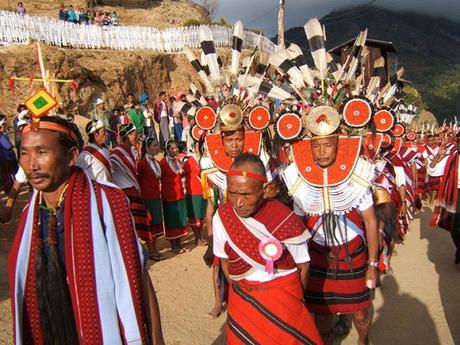Naga ethnic group is multinational region resides in northwest Myanmar and scattered in Assam, Nagaland, Manipur and Arunachal Pradesh. Major ethnic groups may mention as Angami, Ao, Chakesang, Chang, Katcha, Khiamnungan, Konyak, Liangmei, Lainong ...

In Myanmar, some 150,000 people divided into 64 Naga tribal groups own, each tribe includes many clans symbiosis, mainly residents of the Chindwin river basin in the foothills of Saramati (Chin state, Myanmar).
Read more:
8 days in myanmar
Naga society organizations under the link model village within the self-governing general regulations of the federal government. Many groups hold a collective Naga private armies to protect the whole community. In each village, we build checkpoints on the trees themselves to observing static dynamic in the region.
Weekdays, men shirtless, shorts or loincloths. Women wore dresses and transport (short or long depending on region). At the festival, men and women give up their decorations for the colorful costumes and hats headed impressive. Dangling on their neck tiger teeth, claw bear, symbol of victory and symbolizes social positions.
Naga people live mainly on forests and cultivated style "petals strains executioner" (slash burning tree planting) on upland slopes or hillsides terraced edge along the Chindwin River. Men linked themselves into groups hunting in the woods, while women have more traditional brocade weaving at home. The literacy rate in the community is about 61% Naga.
Naga outspoken person, honest, hardworking, brave and hot-tempered. Every man is a true warrior. Strength and courage is a measure of masculinity and their position in the community.
Naga people celebrate throughout the year. Get the groups Lainong as an example, the popular festival may matter as festival Kai-en (earlier this spring), Lor Sorh Stars (Mass down copper), Au Zeh (ceremony apologizing to victims of headhunters ), Auk-sa (celebration sowing), Shau Kyoh Vee (festival reap) ... Each ethnic group has its own festival, but all the people who share the Naga new year festival Kaing Bi - festival the most important of them.

Kaing Bi Tet usually held on the 15 th, 16 January every year, is a chance reunion community. Can say the festival is an opportunity converge, meet, exchange of various cultural flow Naga, an opportunity together to preserve and promote traditional cultural capital in their thousands. Center so people usually congregate Lahe hill - where supposedly sacred lands.
From a few days before Tet, the Naga busy rehearsing traditional dances to serve the festival and contribute to maintaining tradition. The arena was built, decorated with a beautiful port with the symbol very unique offering.
Before the ceremony took place, it was carried up the sacred pillars at the front of village houses (morung), along which people pray for prosperous new year. The sacred pillars bevelled plane, on which the laminated decorative red, white, black V-shaped traditionally
Next, one column chickens as animals sacrificed on plinth. A priest sprinkled a few drops of alcohol on her chicken, mouth pray the gods to bless the new year better off communities.
Then they cut a chicken, chicken blood to erupt around the plinth as a sign of good luck. Then the wine bowl banana leaf cup containers, the bowl of cereal and offerings are laid out to offer to the gods.
Immediately after conducting rites, each group of Naga represent each village began to dance associations. From Naga dances look very strong, often combining rhythm of the whole body (head, arms, legs).
The dances are complemented lines marking edged sword into the air and soared partly reflected vividly farming lifestyle and their daily hunting. Each village is a dance, so the festival lasts until midnight. Interspersed with music and dances collapsed xình strong green forest, people still organizing things, jumping stalls, drumming competition, performance, blowing horns and bamboo flute ...
The festival ends with a ritual fire and dance collectives. For Naga, Kaing Bi fun day festival will be the motivation for them to continue the journey to live for a year later.
